Detailed Examination of the Asian Crisis and Its Impact in Indonesia
VerifiedAdded on 2022/10/02
|9
|1736
|222
Report
AI Summary
This report provides a detailed analysis of the Asian crisis in Indonesia, specifically focusing on the events of 1998. It examines the economic, political, and social factors that contributed to the crisis, including the collapse of the Rupiah, political instability, and social tensions, particularly those targeting the Chinese population. The report delves into the causes of the May riots, the impact of the violence, and the subsequent recovery process, including the political transition following Soeharto's resignation. It also compares the situation in Indonesia in 1998 with the present day, highlighting the significant transformations in the political and economic landscape. The report concludes with a summary of the crisis and its lasting impact on Indonesia.
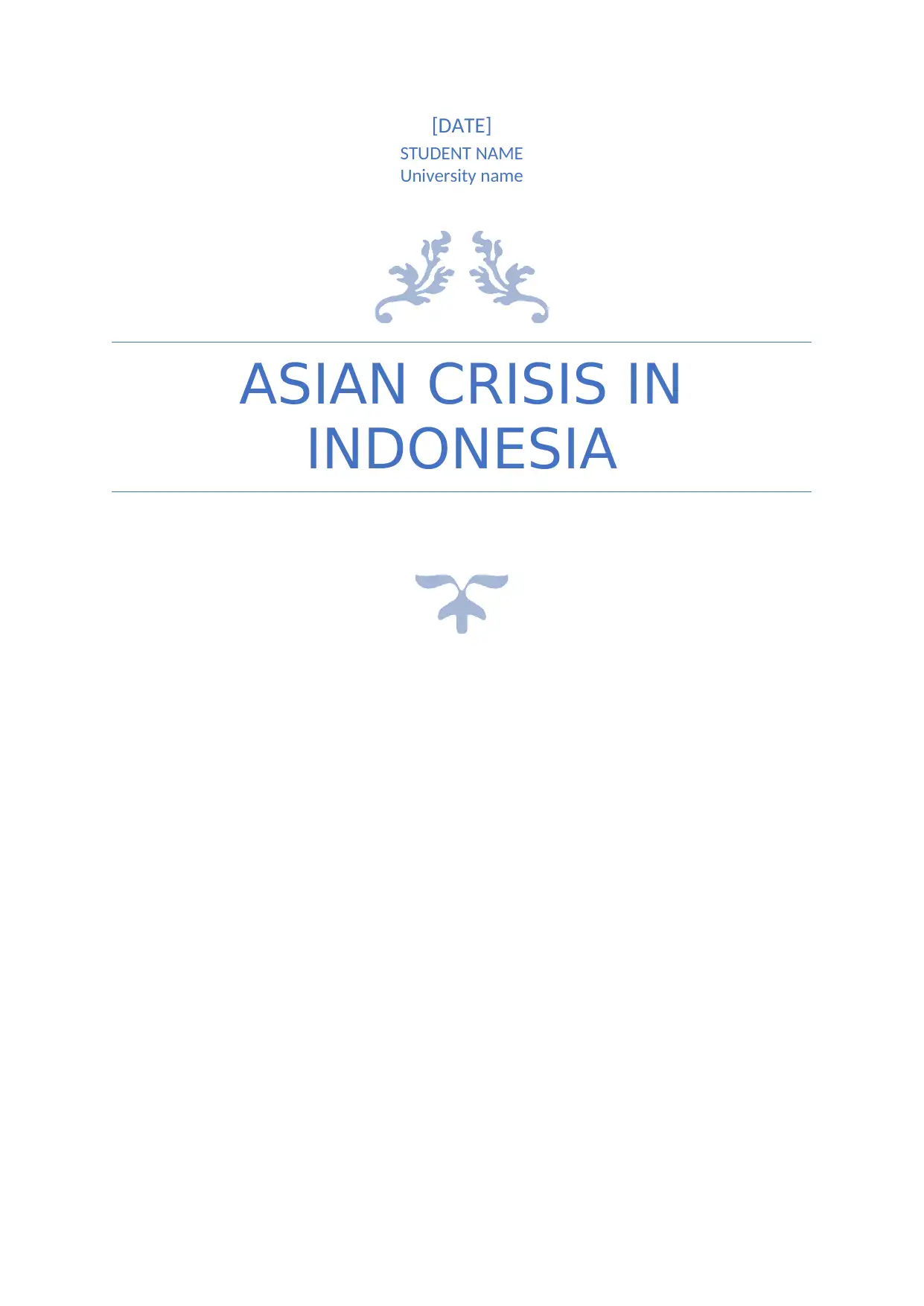
ASIAN CRISIS IN
INDONESIA
[DATE]
STUDENT NAME
University name
INDONESIA
[DATE]
STUDENT NAME
University name
Paraphrase This Document
Need a fresh take? Get an instant paraphrase of this document with our AI Paraphraser
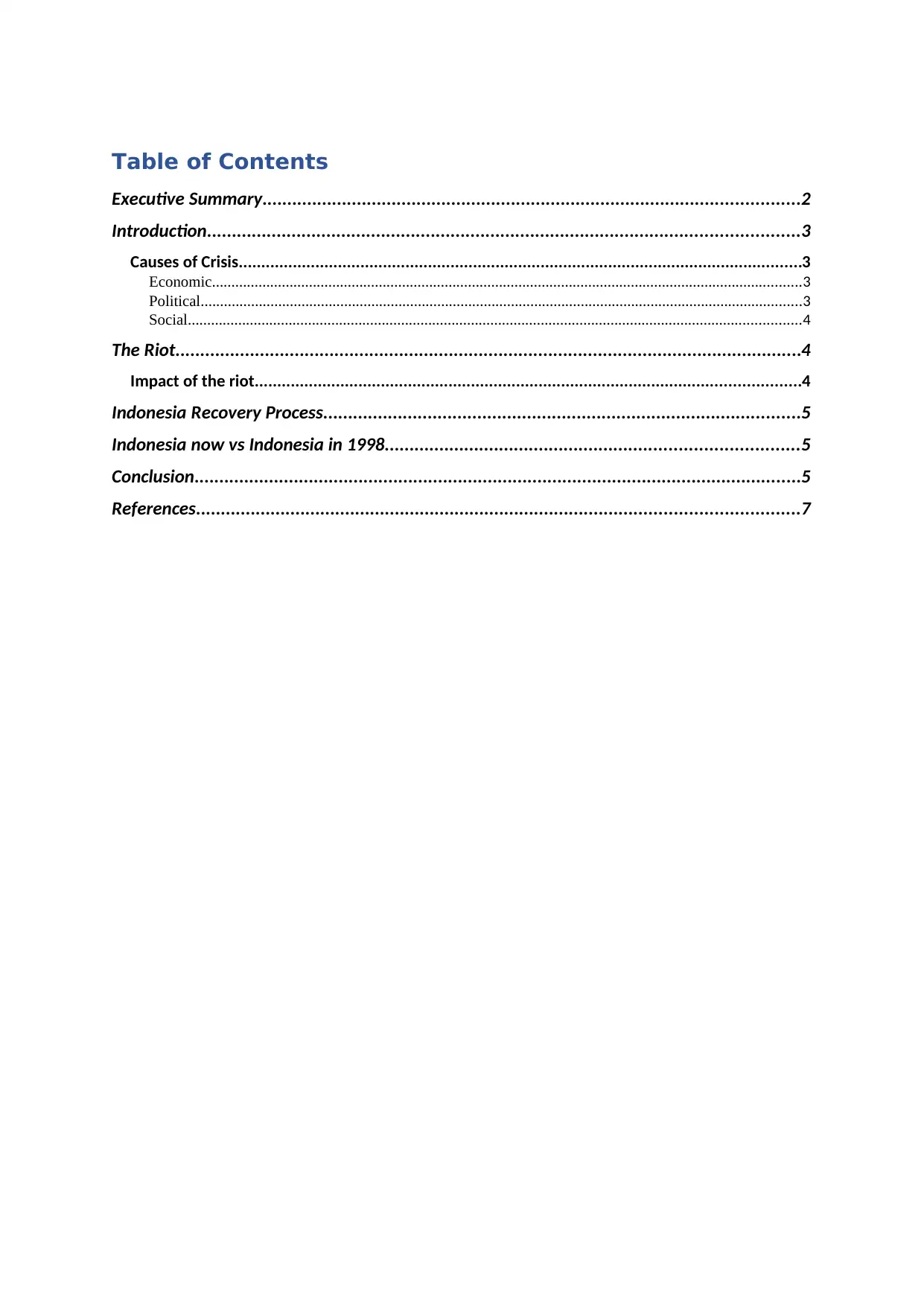
Table of Contents
Executive Summary............................................................................................................2
Introduction.......................................................................................................................3
Causes of Crisis.............................................................................................................................3
Economic........................................................................................................................................................3
Political...........................................................................................................................................................3
Social..............................................................................................................................................................4
The Riot..............................................................................................................................4
Impact of the riot.........................................................................................................................4
Indonesia Recovery Process................................................................................................5
Indonesia now vs Indonesia in 1998...................................................................................5
Conclusion..........................................................................................................................5
References.........................................................................................................................7
Executive Summary............................................................................................................2
Introduction.......................................................................................................................3
Causes of Crisis.............................................................................................................................3
Economic........................................................................................................................................................3
Political...........................................................................................................................................................3
Social..............................................................................................................................................................4
The Riot..............................................................................................................................4
Impact of the riot.........................................................................................................................4
Indonesia Recovery Process................................................................................................5
Indonesia now vs Indonesia in 1998...................................................................................5
Conclusion..........................................................................................................................5
References.........................................................................................................................7
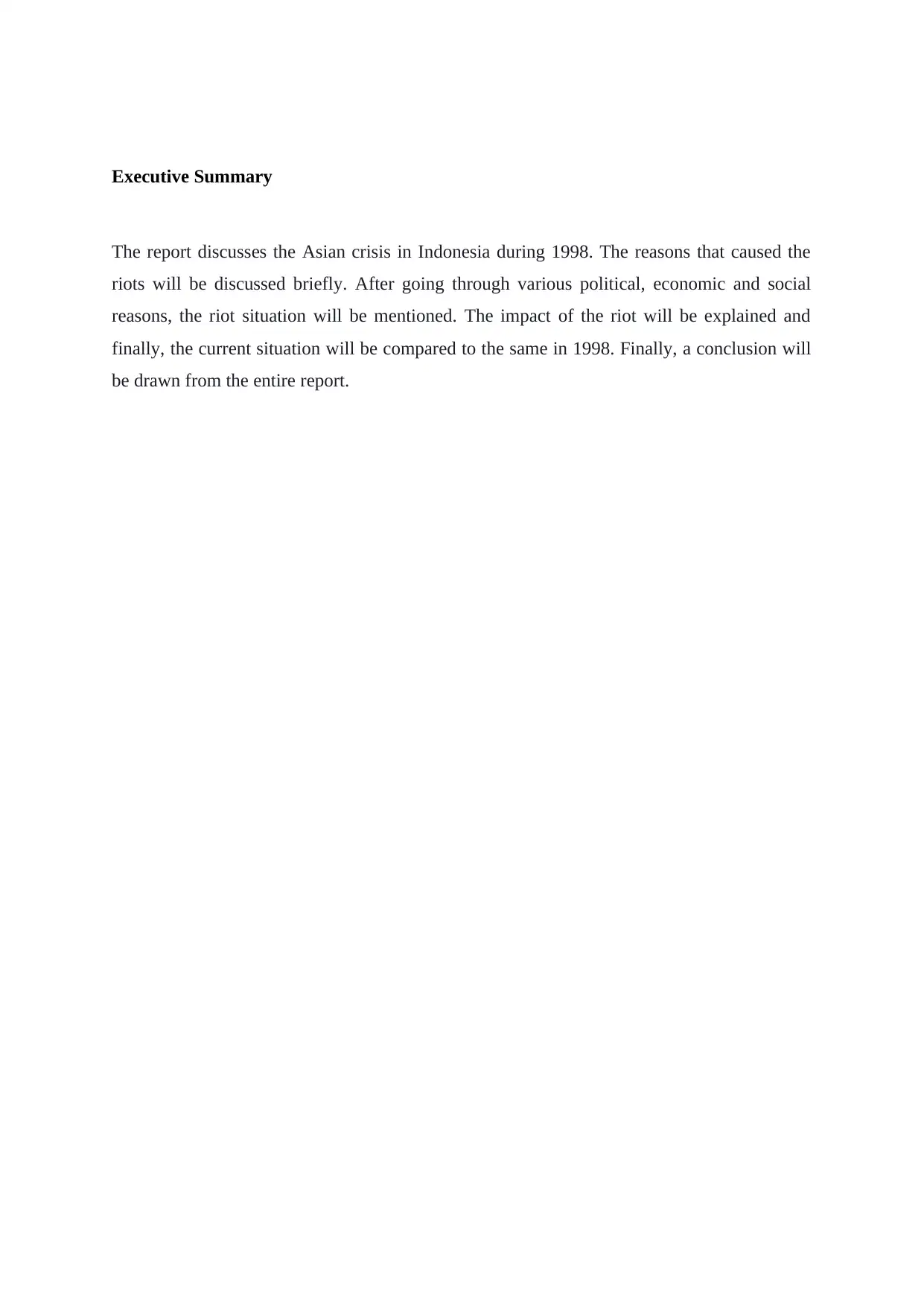
Executive Summary
The report discusses the Asian crisis in Indonesia during 1998. The reasons that caused the
riots will be discussed briefly. After going through various political, economic and social
reasons, the riot situation will be mentioned. The impact of the riot will be explained and
finally, the current situation will be compared to the same in 1998. Finally, a conclusion will
be drawn from the entire report.
The report discusses the Asian crisis in Indonesia during 1998. The reasons that caused the
riots will be discussed briefly. After going through various political, economic and social
reasons, the riot situation will be mentioned. The impact of the riot will be explained and
finally, the current situation will be compared to the same in 1998. Finally, a conclusion will
be drawn from the entire report.
⊘ This is a preview!⊘
Do you want full access?
Subscribe today to unlock all pages.

Trusted by 1+ million students worldwide
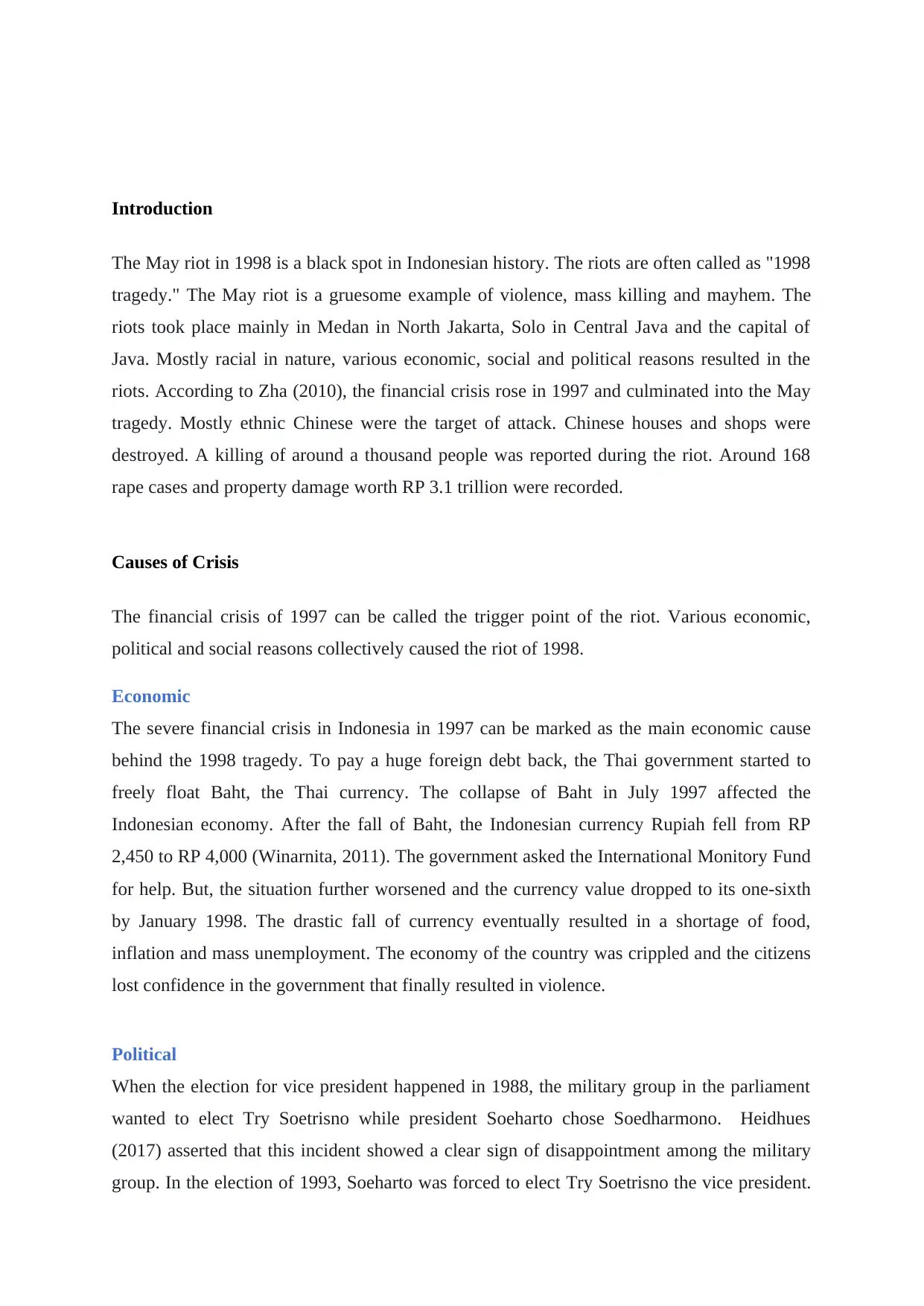
Introduction
The May riot in 1998 is a black spot in Indonesian history. The riots are often called as "1998
tragedy." The May riot is a gruesome example of violence, mass killing and mayhem. The
riots took place mainly in Medan in North Jakarta, Solo in Central Java and the capital of
Java. Mostly racial in nature, various economic, social and political reasons resulted in the
riots. According to Zha (2010), the financial crisis rose in 1997 and culminated into the May
tragedy. Mostly ethnic Chinese were the target of attack. Chinese houses and shops were
destroyed. A killing of around a thousand people was reported during the riot. Around 168
rape cases and property damage worth RP 3.1 trillion were recorded.
Causes of Crisis
The financial crisis of 1997 can be called the trigger point of the riot. Various economic,
political and social reasons collectively caused the riot of 1998.
Economic
The severe financial crisis in Indonesia in 1997 can be marked as the main economic cause
behind the 1998 tragedy. To pay a huge foreign debt back, the Thai government started to
freely float Baht, the Thai currency. The collapse of Baht in July 1997 affected the
Indonesian economy. After the fall of Baht, the Indonesian currency Rupiah fell from RP
2,450 to RP 4,000 (Winarnita, 2011). The government asked the International Monitory Fund
for help. But, the situation further worsened and the currency value dropped to its one-sixth
by January 1998. The drastic fall of currency eventually resulted in a shortage of food,
inflation and mass unemployment. The economy of the country was crippled and the citizens
lost confidence in the government that finally resulted in violence.
Political
When the election for vice president happened in 1988, the military group in the parliament
wanted to elect Try Soetrisno while president Soeharto chose Soedharmono. Heidhues
(2017) asserted that this incident showed a clear sign of disappointment among the military
group. In the election of 1993, Soeharto was forced to elect Try Soetrisno the vice president.
The May riot in 1998 is a black spot in Indonesian history. The riots are often called as "1998
tragedy." The May riot is a gruesome example of violence, mass killing and mayhem. The
riots took place mainly in Medan in North Jakarta, Solo in Central Java and the capital of
Java. Mostly racial in nature, various economic, social and political reasons resulted in the
riots. According to Zha (2010), the financial crisis rose in 1997 and culminated into the May
tragedy. Mostly ethnic Chinese were the target of attack. Chinese houses and shops were
destroyed. A killing of around a thousand people was reported during the riot. Around 168
rape cases and property damage worth RP 3.1 trillion were recorded.
Causes of Crisis
The financial crisis of 1997 can be called the trigger point of the riot. Various economic,
political and social reasons collectively caused the riot of 1998.
Economic
The severe financial crisis in Indonesia in 1997 can be marked as the main economic cause
behind the 1998 tragedy. To pay a huge foreign debt back, the Thai government started to
freely float Baht, the Thai currency. The collapse of Baht in July 1997 affected the
Indonesian economy. After the fall of Baht, the Indonesian currency Rupiah fell from RP
2,450 to RP 4,000 (Winarnita, 2011). The government asked the International Monitory Fund
for help. But, the situation further worsened and the currency value dropped to its one-sixth
by January 1998. The drastic fall of currency eventually resulted in a shortage of food,
inflation and mass unemployment. The economy of the country was crippled and the citizens
lost confidence in the government that finally resulted in violence.
Political
When the election for vice president happened in 1988, the military group in the parliament
wanted to elect Try Soetrisno while president Soeharto chose Soedharmono. Heidhues
(2017) asserted that this incident showed a clear sign of disappointment among the military
group. In the election of 1993, Soeharto was forced to elect Try Soetrisno the vice president.
Paraphrase This Document
Need a fresh take? Get an instant paraphrase of this document with our AI Paraphraser
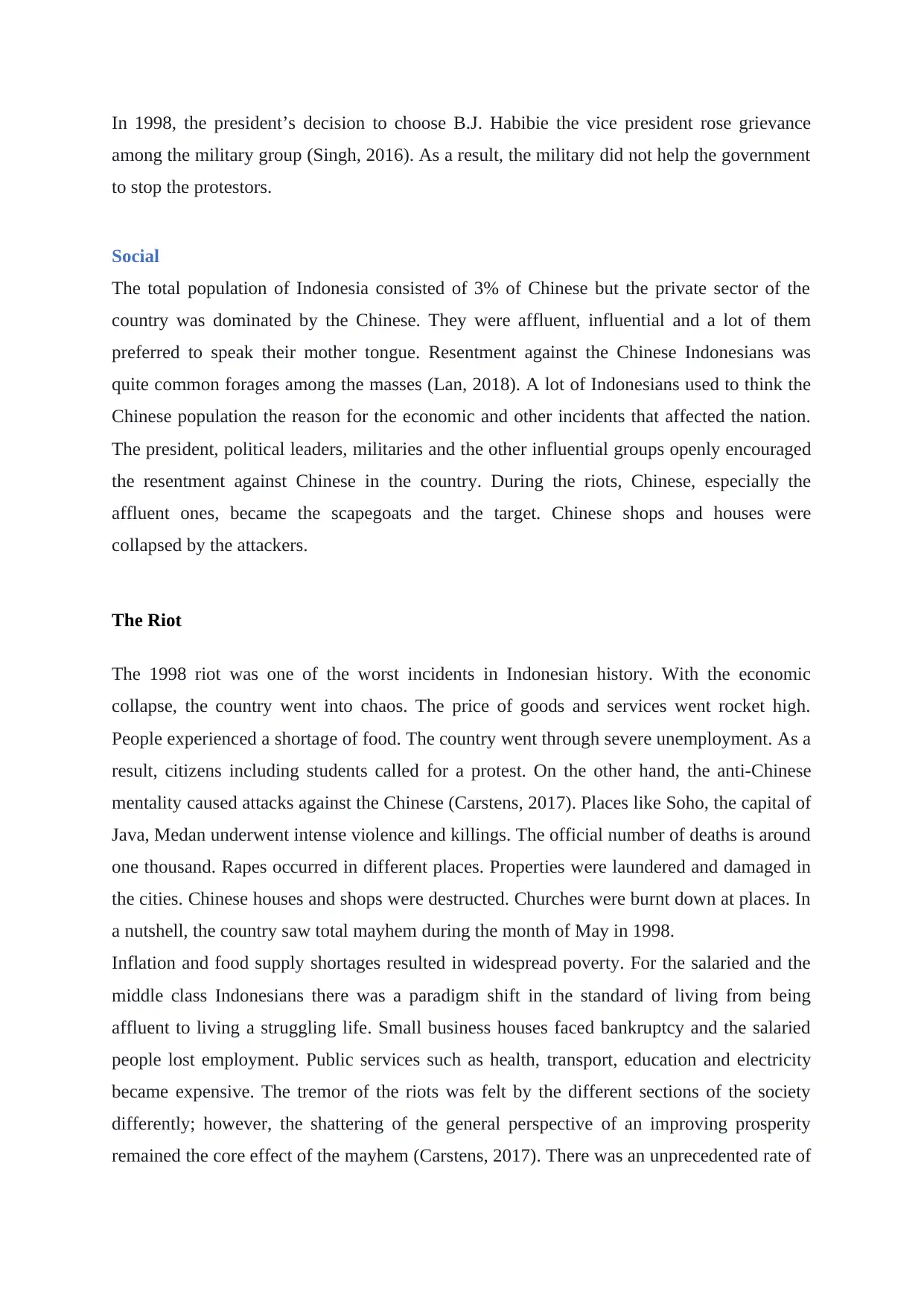
In 1998, the president’s decision to choose B.J. Habibie the vice president rose grievance
among the military group (Singh, 2016). As a result, the military did not help the government
to stop the protestors.
Social
The total population of Indonesia consisted of 3% of Chinese but the private sector of the
country was dominated by the Chinese. They were affluent, influential and a lot of them
preferred to speak their mother tongue. Resentment against the Chinese Indonesians was
quite common forages among the masses (Lan, 2018). A lot of Indonesians used to think the
Chinese population the reason for the economic and other incidents that affected the nation.
The president, political leaders, militaries and the other influential groups openly encouraged
the resentment against Chinese in the country. During the riots, Chinese, especially the
affluent ones, became the scapegoats and the target. Chinese shops and houses were
collapsed by the attackers.
The Riot
The 1998 riot was one of the worst incidents in Indonesian history. With the economic
collapse, the country went into chaos. The price of goods and services went rocket high.
People experienced a shortage of food. The country went through severe unemployment. As a
result, citizens including students called for a protest. On the other hand, the anti-Chinese
mentality caused attacks against the Chinese (Carstens, 2017). Places like Soho, the capital of
Java, Medan underwent intense violence and killings. The official number of deaths is around
one thousand. Rapes occurred in different places. Properties were laundered and damaged in
the cities. Chinese houses and shops were destructed. Churches were burnt down at places. In
a nutshell, the country saw total mayhem during the month of May in 1998.
Inflation and food supply shortages resulted in widespread poverty. For the salaried and the
middle class Indonesians there was a paradigm shift in the standard of living from being
affluent to living a struggling life. Small business houses faced bankruptcy and the salaried
people lost employment. Public services such as health, transport, education and electricity
became expensive. The tremor of the riots was felt by the different sections of the society
differently; however, the shattering of the general perspective of an improving prosperity
remained the core effect of the mayhem (Carstens, 2017). There was an unprecedented rate of
among the military group (Singh, 2016). As a result, the military did not help the government
to stop the protestors.
Social
The total population of Indonesia consisted of 3% of Chinese but the private sector of the
country was dominated by the Chinese. They were affluent, influential and a lot of them
preferred to speak their mother tongue. Resentment against the Chinese Indonesians was
quite common forages among the masses (Lan, 2018). A lot of Indonesians used to think the
Chinese population the reason for the economic and other incidents that affected the nation.
The president, political leaders, militaries and the other influential groups openly encouraged
the resentment against Chinese in the country. During the riots, Chinese, especially the
affluent ones, became the scapegoats and the target. Chinese shops and houses were
collapsed by the attackers.
The Riot
The 1998 riot was one of the worst incidents in Indonesian history. With the economic
collapse, the country went into chaos. The price of goods and services went rocket high.
People experienced a shortage of food. The country went through severe unemployment. As a
result, citizens including students called for a protest. On the other hand, the anti-Chinese
mentality caused attacks against the Chinese (Carstens, 2017). Places like Soho, the capital of
Java, Medan underwent intense violence and killings. The official number of deaths is around
one thousand. Rapes occurred in different places. Properties were laundered and damaged in
the cities. Chinese houses and shops were destructed. Churches were burnt down at places. In
a nutshell, the country saw total mayhem during the month of May in 1998.
Inflation and food supply shortages resulted in widespread poverty. For the salaried and the
middle class Indonesians there was a paradigm shift in the standard of living from being
affluent to living a struggling life. Small business houses faced bankruptcy and the salaried
people lost employment. Public services such as health, transport, education and electricity
became expensive. The tremor of the riots was felt by the different sections of the society
differently; however, the shattering of the general perspective of an improving prosperity
remained the core effect of the mayhem (Carstens, 2017). There was an unprecedented rate of
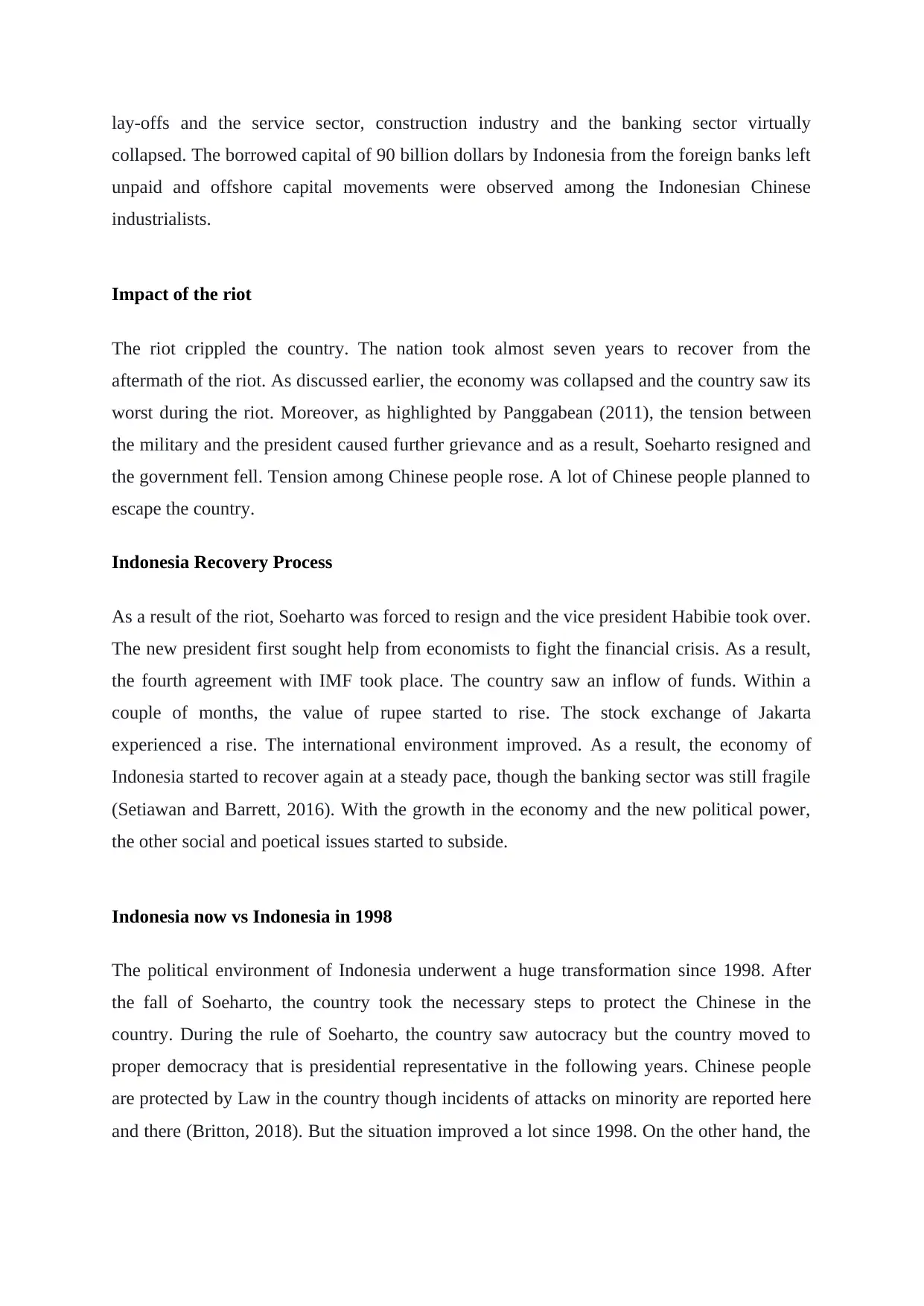
lay-offs and the service sector, construction industry and the banking sector virtually
collapsed. The borrowed capital of 90 billion dollars by Indonesia from the foreign banks left
unpaid and offshore capital movements were observed among the Indonesian Chinese
industrialists.
Impact of the riot
The riot crippled the country. The nation took almost seven years to recover from the
aftermath of the riot. As discussed earlier, the economy was collapsed and the country saw its
worst during the riot. Moreover, as highlighted by Panggabean (2011), the tension between
the military and the president caused further grievance and as a result, Soeharto resigned and
the government fell. Tension among Chinese people rose. A lot of Chinese people planned to
escape the country.
Indonesia Recovery Process
As a result of the riot, Soeharto was forced to resign and the vice president Habibie took over.
The new president first sought help from economists to fight the financial crisis. As a result,
the fourth agreement with IMF took place. The country saw an inflow of funds. Within a
couple of months, the value of rupee started to rise. The stock exchange of Jakarta
experienced a rise. The international environment improved. As a result, the economy of
Indonesia started to recover again at a steady pace, though the banking sector was still fragile
(Setiawan and Barrett, 2016). With the growth in the economy and the new political power,
the other social and poetical issues started to subside.
Indonesia now vs Indonesia in 1998
The political environment of Indonesia underwent a huge transformation since 1998. After
the fall of Soeharto, the country took the necessary steps to protect the Chinese in the
country. During the rule of Soeharto, the country saw autocracy but the country moved to
proper democracy that is presidential representative in the following years. Chinese people
are protected by Law in the country though incidents of attacks on minority are reported here
and there (Britton, 2018). But the situation improved a lot since 1998. On the other hand, the
collapsed. The borrowed capital of 90 billion dollars by Indonesia from the foreign banks left
unpaid and offshore capital movements were observed among the Indonesian Chinese
industrialists.
Impact of the riot
The riot crippled the country. The nation took almost seven years to recover from the
aftermath of the riot. As discussed earlier, the economy was collapsed and the country saw its
worst during the riot. Moreover, as highlighted by Panggabean (2011), the tension between
the military and the president caused further grievance and as a result, Soeharto resigned and
the government fell. Tension among Chinese people rose. A lot of Chinese people planned to
escape the country.
Indonesia Recovery Process
As a result of the riot, Soeharto was forced to resign and the vice president Habibie took over.
The new president first sought help from economists to fight the financial crisis. As a result,
the fourth agreement with IMF took place. The country saw an inflow of funds. Within a
couple of months, the value of rupee started to rise. The stock exchange of Jakarta
experienced a rise. The international environment improved. As a result, the economy of
Indonesia started to recover again at a steady pace, though the banking sector was still fragile
(Setiawan and Barrett, 2016). With the growth in the economy and the new political power,
the other social and poetical issues started to subside.
Indonesia now vs Indonesia in 1998
The political environment of Indonesia underwent a huge transformation since 1998. After
the fall of Soeharto, the country took the necessary steps to protect the Chinese in the
country. During the rule of Soeharto, the country saw autocracy but the country moved to
proper democracy that is presidential representative in the following years. Chinese people
are protected by Law in the country though incidents of attacks on minority are reported here
and there (Britton, 2018). But the situation improved a lot since 1998. On the other hand, the
⊘ This is a preview!⊘
Do you want full access?
Subscribe today to unlock all pages.

Trusted by 1+ million students worldwide
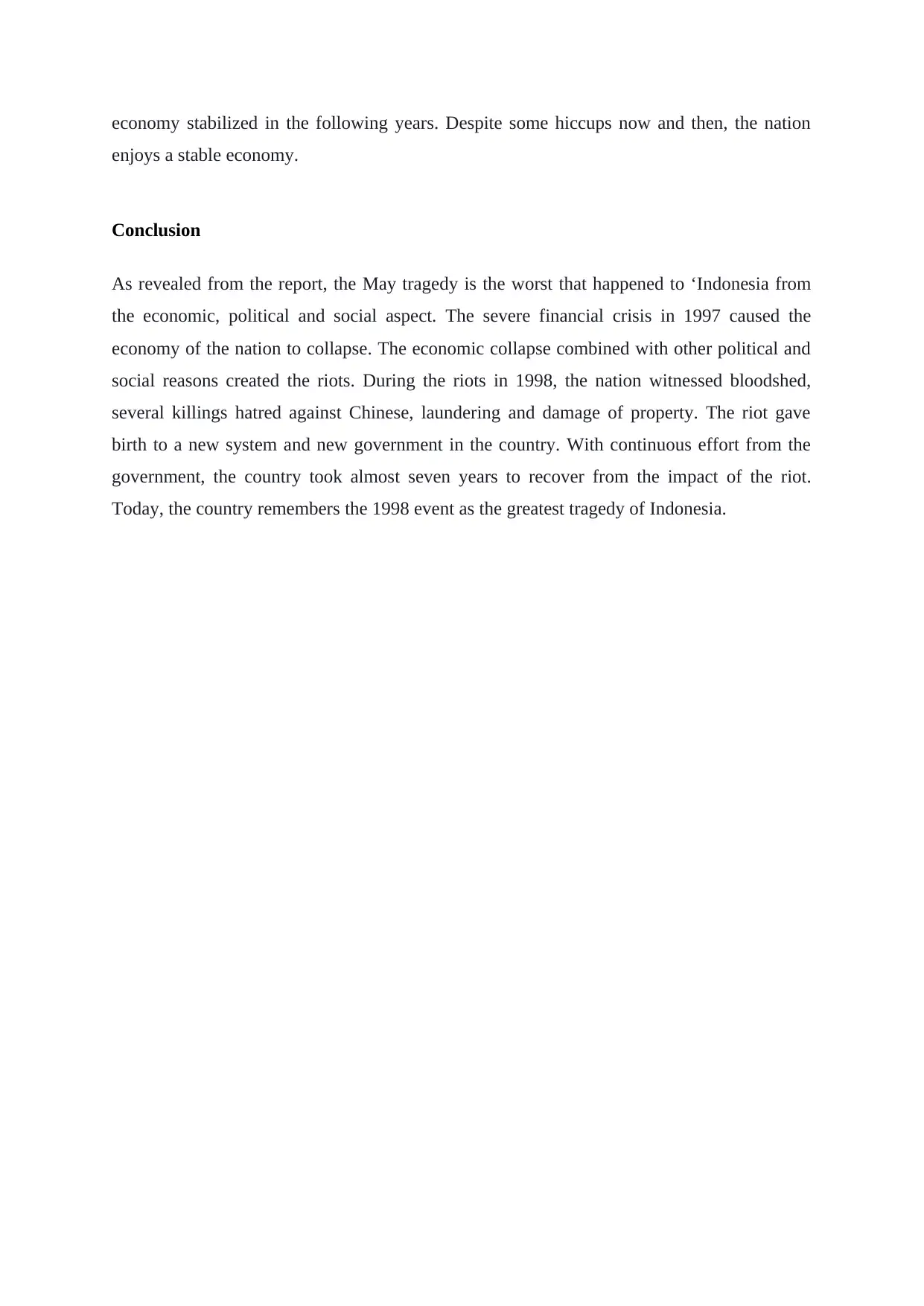
economy stabilized in the following years. Despite some hiccups now and then, the nation
enjoys a stable economy.
Conclusion
As revealed from the report, the May tragedy is the worst that happened to ‘Indonesia from
the economic, political and social aspect. The severe financial crisis in 1997 caused the
economy of the nation to collapse. The economic collapse combined with other political and
social reasons created the riots. During the riots in 1998, the nation witnessed bloodshed,
several killings hatred against Chinese, laundering and damage of property. The riot gave
birth to a new system and new government in the country. With continuous effort from the
government, the country took almost seven years to recover from the impact of the riot.
Today, the country remembers the 1998 event as the greatest tragedy of Indonesia.
enjoys a stable economy.
Conclusion
As revealed from the report, the May tragedy is the worst that happened to ‘Indonesia from
the economic, political and social aspect. The severe financial crisis in 1997 caused the
economy of the nation to collapse. The economic collapse combined with other political and
social reasons created the riots. During the riots in 1998, the nation witnessed bloodshed,
several killings hatred against Chinese, laundering and damage of property. The riot gave
birth to a new system and new government in the country. With continuous effort from the
government, the country took almost seven years to recover from the impact of the riot.
Today, the country remembers the 1998 event as the greatest tragedy of Indonesia.
Paraphrase This Document
Need a fresh take? Get an instant paraphrase of this document with our AI Paraphraser
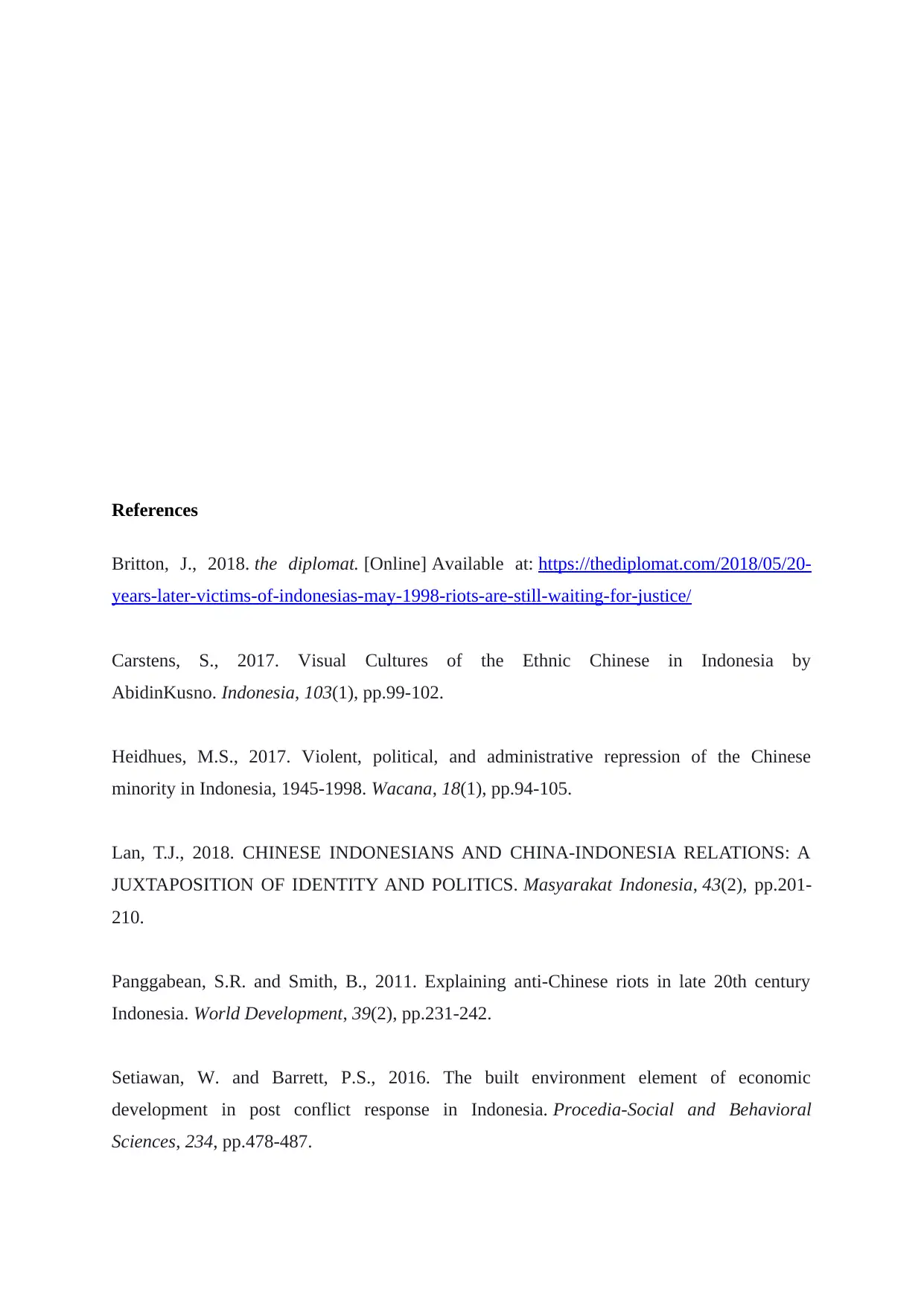
References
Britton, J., 2018. the diplomat. [Online] Available at: https://thediplomat.com/2018/05/20-
years-later-victims-of-indonesias-may-1998-riots-are-still-waiting-for-justice/
Carstens, S., 2017. Visual Cultures of the Ethnic Chinese in Indonesia by
AbidinKusno. Indonesia, 103(1), pp.99-102.
Heidhues, M.S., 2017. Violent, political, and administrative repression of the Chinese
minority in Indonesia, 1945-1998. Wacana, 18(1), pp.94-105.
Lan, T.J., 2018. CHINESE INDONESIANS AND CHINA-INDONESIA RELATIONS: A
JUXTAPOSITION OF IDENTITY AND POLITICS. Masyarakat Indonesia, 43(2), pp.201-
210.
Panggabean, S.R. and Smith, B., 2011. Explaining anti-Chinese riots in late 20th century
Indonesia. World Development, 39(2), pp.231-242.
Setiawan, W. and Barrett, P.S., 2016. The built environment element of economic
development in post conflict response in Indonesia. Procedia-Social and Behavioral
Sciences, 234, pp.478-487.
Britton, J., 2018. the diplomat. [Online] Available at: https://thediplomat.com/2018/05/20-
years-later-victims-of-indonesias-may-1998-riots-are-still-waiting-for-justice/
Carstens, S., 2017. Visual Cultures of the Ethnic Chinese in Indonesia by
AbidinKusno. Indonesia, 103(1), pp.99-102.
Heidhues, M.S., 2017. Violent, political, and administrative repression of the Chinese
minority in Indonesia, 1945-1998. Wacana, 18(1), pp.94-105.
Lan, T.J., 2018. CHINESE INDONESIANS AND CHINA-INDONESIA RELATIONS: A
JUXTAPOSITION OF IDENTITY AND POLITICS. Masyarakat Indonesia, 43(2), pp.201-
210.
Panggabean, S.R. and Smith, B., 2011. Explaining anti-Chinese riots in late 20th century
Indonesia. World Development, 39(2), pp.231-242.
Setiawan, W. and Barrett, P.S., 2016. The built environment element of economic
development in post conflict response in Indonesia. Procedia-Social and Behavioral
Sciences, 234, pp.478-487.

Singh, B., 2016. Succession politics in Indonesia: the 1998 presidential elections and the fall
of Suharto. Springer.
Winarnita, M.S., 2011. The politics of commemorating the May 1998 mass rapes. RIMA:
Review of Indonesian and Malaysian Affairs, 45(1/2), p.133.
Zha, D., 2010. China and the May 1998 riots of Indonesia: exploring the issues. The Pacific
Review, 13(4), pp. 557-575.
of Suharto. Springer.
Winarnita, M.S., 2011. The politics of commemorating the May 1998 mass rapes. RIMA:
Review of Indonesian and Malaysian Affairs, 45(1/2), p.133.
Zha, D., 2010. China and the May 1998 riots of Indonesia: exploring the issues. The Pacific
Review, 13(4), pp. 557-575.
⊘ This is a preview!⊘
Do you want full access?
Subscribe today to unlock all pages.

Trusted by 1+ million students worldwide
1 out of 9
Your All-in-One AI-Powered Toolkit for Academic Success.
+13062052269
info@desklib.com
Available 24*7 on WhatsApp / Email
![[object Object]](/_next/static/media/star-bottom.7253800d.svg)
Unlock your academic potential
Copyright © 2020–2025 A2Z Services. All Rights Reserved. Developed and managed by ZUCOL.
